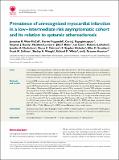Prevalence of unrecognized myocardial infarction in a low-intermediate risk asymptomatic cohort and its relation to systemic atherosclerosis
Abstract
Aims : Unrecognized myocardial infarctions (UMIs) have been described in 19-30% of the general population using late gadolinium enhancement (LGE) on cardiac magnetic resonance. However, these studies have focused on an unselected cohort including those with known cardiovascular disease (CVD). The aim of the current study was to ascertain the prevalence of UMIs in a non-high-risk population using magnetic resonance imaging (MRI). Methods and Results : A total of 5000 volunteers aged >40 years with no history of CVD and a 10-year risk of CVD of <20%, as assessed by the ATP-III risk score, were recruited to the Tayside Screening for Cardiac Events study. Those with a B-type natriuretic peptide (BNP) level greater than their gender-specific median were invited for a whole-body MR angiogram and cardiac MR including LGE assessment. LGE was classed as absent, UMI, or non-specific. A total of 1529 volunteers completed the imaging study; of these, 53 (3.6%) were excluded because of either missing data or inadequate LGE image quality. Ten of the remaining 1476 (0.67%) displayed LGE. Of these, three (0.2%) were consistent with UMI, whereas seven were non-specific occurring in the mid-myocardium (n = 4), epicardium (n = 1), or right ventricular insertion points (n = 2). Those with UMI had a significantly higher BNP [median 116 (range 31-133) vs. 22.6 (5-175) pg/mL, P = 0.015], lower ejection fraction [54.6 (36-62) vs. 68.9 (38-89)%, P = 0.007], and larger end-systolic volume [36.3 (27-61) vs. 21.7 (5-65) mL/m(2), P = 0.014]. Those with non-specific LGE had lower diastolic blood pressure [68 (54-70) vs. 72 (46-98) mmHg, P = 0.013] but no differences in their cardiac function. Conclusion : Despite previous reports describing high prevalence of UMI in older populations, in a predominantly middle-aged cohort, those who are of intermediate or low cardiovascular risk have a very low risk of having an unrecognized myocardial infarct.
Citation
Weir-McCall , J R , Fitzgerald , K , Papagiorcopulo , C J , Gandy , S J , Lambert , M , Belch , J J F , Cavin , I , Littleford , R , Macfarlane , J A , Matthew , S Z , Nicholas , R S , Struthers , A D , Sullivan , F M , Waugh , S A , White , R D & Houston , J G 2016 , ' Prevalence of unrecognized myocardial infarction in a low-intermediate risk asymptomatic cohort and its relation to systemic atherosclerosis ' , European Heart Journal - Cardiovascular Imaging . https://doi.org/10.1093/ehjci/jew155
Publication
European Heart Journal - Cardiovascular Imaging
Status
Peer reviewed
ISSN
2047-2404Type
Journal article
Description
The study was funded by the Souter Charitable Foundation and the Chest, Heart and Stroke Scotland Charity. J.R.W.M. is supported by the Wellcome Trust through the Scottish Translational Medicine and Therapeutics Initiative (grant no. WT 085664) in the form of a clinical research fellowship.Collections
Items in the St Andrews Research Repository are protected by copyright, with all rights reserved, unless otherwise indicated.

